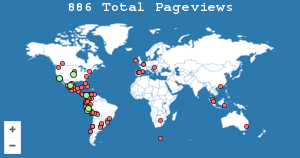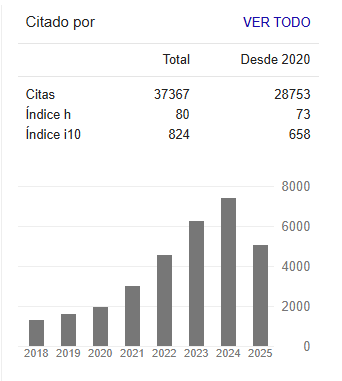Capital Intelectual en el sector bancario peruano
Resumen
El capital intelectual es reconocido como un importante factor de competitividad, creación de valor y rendimiento financiero superior y de manera especial en industrias intensivas en conocimiento como lo es el sector bancario. El presente estudio emplea el valor agregado del coeficiente intelectual (VAIC) para medir el capital intelectual y la contribución de sus dimensiones en la generación de valor en el sector bancario peruano entre los años 2017 al 2020, empleando como fuente los datos financieros publicados por la Superintendencia del Mercado de Valores del Perú. Los resultados evidenciaron un sector sólido y con indicadores de buen desempeño. La dimensión capital humano mostró ser la que más influye en la creación de valor, mientras que el capital físico tiene una influencia poco significativa. Las conclusiones confirman la influencia directa del capital intelectual y capital estructural en la creación de valor. Se concluye la necesidad invertir en intangibles, ya que ello influye directamente en la creación de valor y de ventaja competitiva.
Citas
Ali, B. J., & Anwar, G. (2021). Intellectual capital: A modern model to measure the value creation in a business. International Journal of Engineering, Business and Management, 5(2), 31-43. https://doi.org/10.22161/ijebm.5.2.4
Ali, S., Murtaza, G., Hedvicakova, M., Jiang, J., & Naeem, M. (2022). Intellectual capital and financial performance: A comparative study. Frontiers in Psychology, 13, 967820. https://doi.org/10.3389/fpsyg.2022.967820
Arszułowicz, N. (2019). The concept of intellectual capital and its measurement using the VAIC method on the example of PKN ORLEN. Optimum Economic Studies, 4, 97-111. https://doi.org/10.15290/oes.2019.04.98.08
Asuero, A. G., Sayago, A., & González, A. G. (2006). The Correlation Coefficient: An Overview. Critical Reviews in Analytical Chemistry, 36(1), 41-59. https://doi.org/10.1080/10408340500526766
Banco mundial. (s. f.). Perú Panorama general. https://www.bancomundial.org/es/country/peru/overview
Barney, J. B. (1991). Firm Resources and sustained Competitive Advantage. Economics Meets Sociology in Strategic Management, 17(1), 99-120.
Bontis, N. (1999) Managing Organizational Knowledge by Diagnosing Intellectual Capital: Framing and Advancing the State of the Field. International Journal of Technology Management, 18, 433-463. http://dx.doi.org/10.1504/IJTM.1999.002780
Demuner Flores, M. del R., Saavedra García, M. L., & Camarena Adame, M. E. (2017). Medición del capital intelectual en el sector bancario: Aplicación de los modelos Skandia y VAIC. Innovar, 27(66), 75-89. https://doi.org/10.15446/innovar.v27n66.66712
Dhofar University, Yilmaz, I., Acar, G., & Dhofar University. (2018). The Effects of Intellectual Capital on Financial Performance and Market Value: Evidence from Turkey. Eurasian Journal of Business and Economics, 11(21), 117-133. https://doi.org/10.17015/ejbe.2018.021.07
Edvinsson, L. (2002). Corporate Longitude: What You Need to Know to Navigate the Knowledge Economy. Financial Times Prentice Hall. https://books.google.com.pe/books?id=FaprQgAACAAJ
Edvinsson, L. Y Malone, M.S. (1999). El capital intelectual. Gestión 2000.
Edvinsson, L. Y Malone, M.S. (2000). El capital intelectual cómo identificar y calcular el valor de los recursos intangibles de su empresa. Gestión 2000
Ekaningrum, Y. (2021). The influence of intellectual capital elements on company performance. The Journal of Asian Finance, Economics, and Business, 8(1), 257-269.
Falcón, V. V. (2017). Una mirada al concepto de Capital Intelectual. Revista Uniandes Episteme, 4(4), 491-503.
Ficco, C. (2020). Relevancia valorativa de los activos intangibles y del capital intelectual: Una revisión de la literatura empírica. Revista Academia & Negocios, 6(1), 11-30.
Fijałkowska, J. (2014). Value Added Intellectual Coefficient (VAICTM) as a tool of performance measurement. Przedsiębiorczość i Zarządzanie (Entrepreneurship and Management), 15(1), 129-140.
García, T. (2005). Diseño de un Modelo para la Medición del Capital Intelectual de Empresas de Manufactura en el Perú. Revista de la Facultad de Ingeniería Industrial, UNMSM, 8(2).
Geraldo, L. A., Soria, J. J., & Tito, P. L. (2020). Modelo SEM basado en valores organizacionales y capital intelectual: Un estudio realizado en entidades del sistema financiero peruano. Retos, 10(19), 5-28. https://doi.org/10.17163/ret.n19.2020.01
Githaiga, P. N. (2022). Intellectual capital and bank performance: The moderating role of income diversification. Asia-Pacific Journal of Business Administration. https://doi.org/10.1108/APJBA-06-2021-0259
Gómez-Bayona, L., Londoño-Montoya, E., & Mora-González, B. (2020). Modelos de capital intelectual a nivel empresarial y su aporte en la creación de valor. Revista Cea, 6(11), 165-184.
Iazzolino, G., & Laise, D. (2013). Value added intellectual coefficient (VAIC): A methodological and critical review. Journal of Intellectual Capital, 14(4), 547-563. https://doi.org/10.1108/JIC-12-2012-0107
Kaplan, R. S., & Norton, D. (1996). Using the Balanced Scorecard as a Strategic Management System. Harvard Business Review, 74(1), 65-75.
Khairiyansyah, K., & Vebtasvili, V. (2018). Relationship between Intellectual Capital with Profitability and Productivity in Indonesian Banking Industry. Jurnal Keuangan dan Perbankan, 22(1). https://doi.org/10.26905/jkdp.v22i1.1577
Konno, N., & Schillaci, C. E. (2021). Intellectual capital in Society 5.0 by the lens of the knowledge creation theory. Journal of Intellectual Capital, 22(3), 478-505. https://doi.org/10.1108/JIC-02-2020-0060
Le, T. D. Q., & Nguyen, D. T. (2020). Intellectual capital and bank profitability: New evidence from Vietnam. Cogent Business & Management, 7(1), 1859666. https://doi.org/10.1080/23311975.2020.1859666
Menegus Bornemann, M. (1999). El gobierno de los indios en la Nueva España, siglo XVI. Señores o cabildo. Revista de Indias, 59(217), 599–617. https://doi.org/10.3989/revindias.1999.i217.829
Murale, V., Jayaraj, R., & Ashrafali, A. (2010). Impact of intellectual capital on firm performance: A resource based view using VAIC approach. International Journal of Business Management, Economics and Information Technology, 2(2), 283-292.
Nawaz, T. (2019). Intellectual capital profiles and financial performance of Islamic banks in the UK. International Journal of Learning and Intellectual Capital, 16(1), 87. https://doi.org/10.1504/IJLIC.2019.096934
Nazari, J. & Herremans, I. (2007). Extended VAIC Model: Measuring Intellectual Capital Components. Journal of Intellectual Capital, 8, 595-609.
https://doi.org/10.1108/14691930710830774
Nguyen, D. T., Le, T. D. Q., & Ho, T. H. (2021). Intellectual Capital and Bank Risk in Vietnam—A Quantile Regression Approach. Journal of Risk and Financial Management, 14(1), 27. https://doi.org/10.3390/jrfm14010027
Nguyen, D. T., Le, T. D., & Tran, S. H. (2023). The moderating role of income diversification on the relationship between intellectual capital and bank performance evidence from Viet Nam. Cogent Business & Management, 10(1), 2182621. https://doi.org/10.1080/23311975.2023.2182621
Octavio, D. Q., & Soesetio, Y. (2019). Intellectual capital and bank profitability: Evidence from conventional and Islamic bank in Indonesia. Jurnal Keuangan dan Perbankan, 23(2). https://doi.org/10.26905/jkdp.v23i2.3028
Oktaviana, A. R., & Setiawan, D. (2022). Board Characteristics and Intellectual Capital in Islamic Banks: Evidence from Indonesia, Malaysia and Bangladesh. Falah: Jurnal Ekonomi Syariah, 7(1), 1-12. https://doi.org/10.22219/jes.v7i1.19900
Ozkan, N., Cakan, S., & Kayacan, M. (2017). Intellectual capital and financial performance: A study of the Turkish Banking Sector. Borsa Istanbul Review, 17(3), 190-198. https://doi.org/10.1016/j.bir.2016.03.001
Pulic, A. (1998). Measuring the Performance of Intellectual Potential in Knowledge Economy (presented in 1998 at the 2nd McMaster World Congress on Measuring and Managing Intellectual Capital by the Austrian Team for Intellectual Potential).
Pulic, A. (2008). The Principles of intellectual capital efficiency. A brief description, Croatian Intellectual Capital Center, Zagreb.
Qingdao Agricultural University, School of Management, Xu, J., Liu, F., & Korea University Business School. (2020). The Impact of Intellectual Capital on Firm Performance: A Modified and Extended VAIC Model. Journal of Competitiveness, 12(1), 161-176. https://doi.org/10.7441/joc.2010.01.10
Rahmat, S. M. H. (2020). Intellectual capital, bank size, bank market share, and efficiency of conventional banks in Indonesia. Rev. CEA, 6(11), 71–88. https://doi.org/10.22430/24223182.1457
Robertus, I. (2020). The Impact of Competitive Strategy and Intellectual Capital on SMEs Performance. Jurnal Manajemen, 24(3), 427. https://doi.org/10.24912/jm.v24i3.677
Rudhiningtyas, D. A., Soesetio, Y., & Faizza, C. N. (2022). The Impact of Intellectual Capital Disclosure and Type of Ownership on Evaluation of a Company’s Financial Performance after IPO. AFRE (Accounting and Financial Review), 5(1), 72-82. https://doi.org/10.26905/afr.v5i1.7528
Silva, M. D. L., Costa, V., & Loureiro, P. (2021). Intellectual capital and financial performance of Portuguese tourism sector. Journal of Tourism & Development, 81-91 Páginas. https://doi.org/10.34624/RTD.V1I36.9101
Superintendencia del Mercado de Valores- SMV (s. f.). Información Financiera por Período. https://www.smv.gob.pe/Frm_InformacionFinancieraPorPeriodo?data=16BF4C8EF499F678B5AE402C1CFE8FC16710365A6C
Todericiu, R. (2021). The Impact of Intellectual Capital on the SMEs Performance: A Study of the Romanian Central Region SMEs. Studies in Business and Economics, 16(1), 198-209.
Weqar, F., & Haque, S. M. I. (2022). The influence of intellectual capital on Indian firms’ financial performance. International Journal of Learning and Intellectual Capital, 19(2), 169. https://doi.org/10.1504/IJLIC.2022.121249
Xu, J., Haris, M., & Irfan, M. (2022). The Impact of Intellectual Capital on Bank Profitability during COVID-19: A Comparison with China and Pakistan. Complexity, 2022, 1-10. https://doi.org/10.1155/2022/2112519

Esta obra está bajo licencia internacional Creative Commons Reconocimiento-NoComercial-CompartirIgual 4.0.








.png)






























